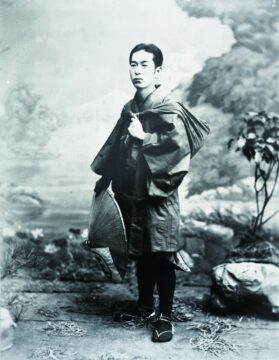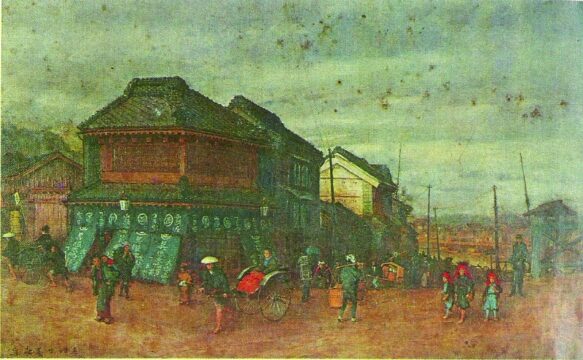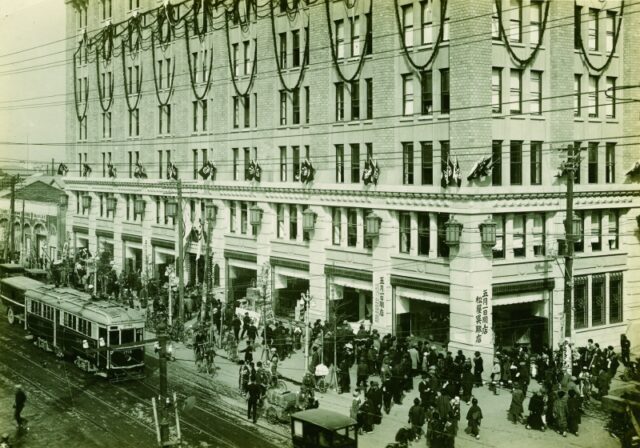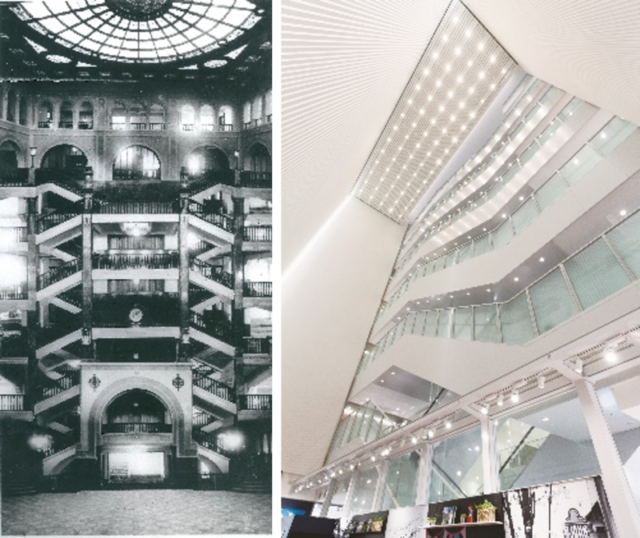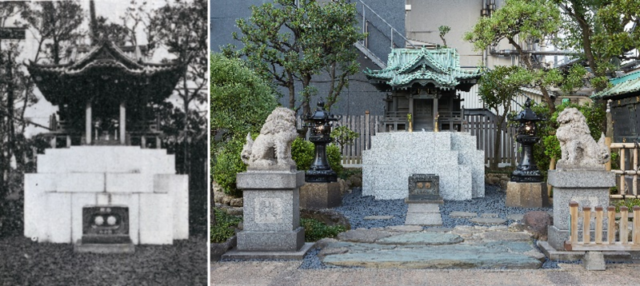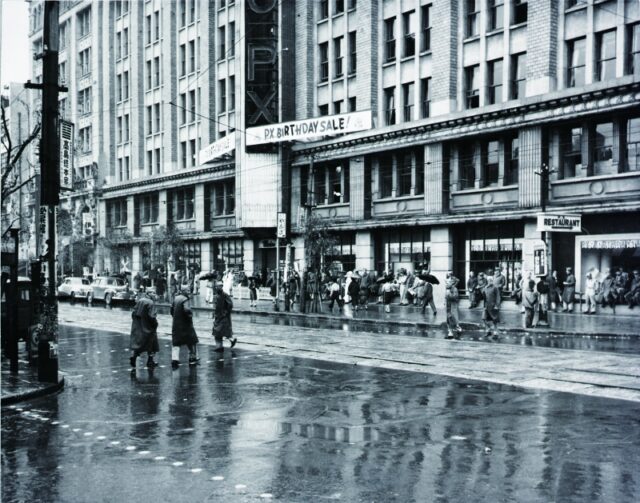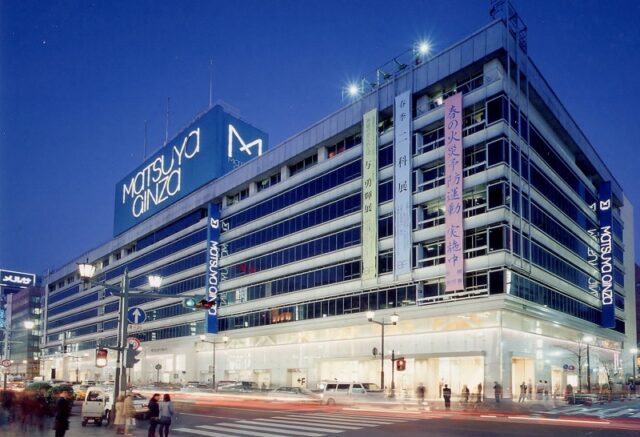
■Dates: April 29th (Tuesday, national holiday) to May 13th (Tuesday)
■ Venue: Matsuya Ginza, Space of Ginza, next to the stairs
We look back on the 100-year history and changes that Matsuya Ginza has gone through.
1868: The first Tokubei Furuya started a kimono intermediate business traveling between Tokyo and Yokohama.
Matsuya's founder, Tokubei Furuya, was born in Yamanashi Prefecture and started his own intermediate business in Yokohama, a bustling city with lively trade following the opening of the port.
A middleman, also known as a buyer, was an intermediary who took orders from kimono retailers, procured goods from wholesalers in Tokyo, and sold them to the retailers.
1869: Tsuruya Kimono Store was founded at Ishikawaguchi, Yokohama.
In 1869 (Meiji 2), Tsuruya Kimono Store, the predecessor of Matsuya, was founded in Kamenohashi, Yokohama, now Ishikawacho. When the first Tokubei was working as a middleman, his wife Masu started selling scraps of cloth, which sold very well, and Tokubei decided to focus on retail sales. The year they started selling the scraps, November 3rd of the Gregorian calendar, was set as the company's founding date.
1890: Imagawabashi store opens (expands to Tokyo)
Later, in 1889 (Meiji 22), they acquired Matsuya Kimono Store, which was then located in Imagawabashi, Kanda (near the current JR Kanda Station), and in 1890 (Meiji 23), they expanded into Tokyo and opened a store there. After coming into the hands of the Furuya family, sales at the Imagawabashi store increased more than six-fold compared to the time of the acquisition, and in 1907 (Meiji 40), they converted it into a department store, opening an imposing three-story Western-style building that was ahead of its time.
1925: Ginza store opens
The Ginza store opened on May 1, 1925 (Taisho 14). The impact of the Great Kanto Earthquake that had occurred two years prior put the opening in jeopardy, but it was able to open safely, and Matsuya was born, boasting the most advanced facilities in the Orient at the time. When the store first opened, it was crowded with so many customers that entry had to be restricted, and although it was customary at the time to change into sandals provided in the store, it is said that the store abolished the shoe storage service and allowed customers to enter with their shoes on. Similar incidents occurred at other department stores around the same time, and this marked the start of the modernization of commerce.
Also, an open-ceiling hall called the Central Hall (now the Space of Ginza) was built on the first floor. The ceiling was decorated with circular stained glass and the first-floor floor was decorated with a checkerboard pattern made of black and white marble. The splendor of the Central Hall was a hot topic at the time.
(Left) The central hall at the time of opening
(Right) Space of Ginza today
1929: Ryuko Fudoson was installed on the roof
It was placed on the rooftop of the store as the guardian deity of Koyasan Ryukoin Temple in Wakayama Prefecture. The treasure hall that enshrines the statue was designed by Aoike Yasutaro, who also designed Heian Shrine and Kanda Myojin Shrine. It is said to bring good luck in career advancement, business prosperity, and competitions, but since "dragon light" is associated with "fashion," it is now also said to bring good luck in the fashion industry.
(Left) In 1929
(Right) Present
1945: The Ginza store was requisitioned by the occupying forces (GHQ).
During and after the war, Matsuya was on the brink of collapse, but the Ginza store continued to operate on a small scale. However, in 1945 (Showa 20), the entire Ginza store was requisitioned by the occupying forces (GHQ), and the company went through difficult times.
1953: After being requisitioned, the Ginza store reopens.
Even during the requisition, Matsuya opened a temporary office and continued business, believing in the "reconstruction of Matsuya." After about seven years of requisition, the requisition was lifted in 1952 (Showa 27), and the long-awaited new store reopened the following year in 1953 (Showa 28). The new store reopening marked a major turning point for Matsuya after the war, and became a symbol of a new start along with the reconstruction of Ginza.
1955: Good Design Corner opened on the 7th floor of the Ginza store (current design collection)
The Good Design Corner, the predecessor of the current design collection, was a select shop selling excellent design goods from around the world, which was launched together with the Japan Design Committee, a group of designers from across all genres. Founding members of the Japan Design Committee included leading figures in Japanese design, such as Taro Okamoto and Yusaku Kamekura. This was the beginning of Matsuya's deep relationship with "design."
Members of the Japan Design Committee were involved in the design of the store's renovation in 2011, with Naoto Fukasawa in charge of the store interior, Kaoru Mende in charge of lighting, and Taku Satoh in charge of graphics.
1964: Ginza store is expanded and reopened.
Following a long-cherished wish, the Matsuya store underwent a large-scale expansion that took up an entire block in Ginza 3-Chome, and reopened after a renovation. At the same time, the design of the Matsuya mark and wrapping paper was completely renewed. The design was created by graphic designer Yusaku Kamekura, who was also a member of the Japan Design Committee, and uses a dynamic original typeface.
2001 Ginza store renovated
This renovation marked an important turning point for Matsuya Ginza to make a major leap into the 21st century.
Hara Kenya of the Nippon Design Center, who was in charge of the new CI strategy, changed the corporate color to "white," which has a transparent feel and evokes an image of high quality and versatility. Thus, "White Matsuya" was born.
2006: LED exterior completed
The white exterior symbolizing the "White Matsuya" was completed in 2006. At the time, the use of LED lighting, which had only just been developed, on the exterior was said to be a groundbreaking idea even by global standards. With 176,400 LED elements embedded in the glass wall, one of the largest in Japan, the exterior became a "shining white box," symbolizing the birth of a new Matsuya. Even today, the "White Matsuya" remains a beloved landmark of the Ginza area.
2013 Ginza store renovation
The entire building was renovated, focusing on the women's and living room departments, for the first time since the major renovation in 2001. As a central measure, an international boutique was opened on the second floor, gathering together trendy brands, further strengthening the strength of Matsuya Ginza, located in the "Global Ginza."
Matsuya celebrates its 150th anniversary in 2019
Matsuya, which celebrated its 150th anniversary in 2019, has further strengthened its long-standing efforts to promote design under the slogan "Matsuya of Design." The store aims to continue to be a department store that enriches people's lives through design.
2025: 100th anniversary of the Ginza store opening
Matsuya Ginza, which opened in 1925, will celebrate its 100th anniversary on May 1st and will hold various projects and events throughout the year to express its gratitude to its customers. Matsuya Ginza will continue to use its 100th anniversary as an opportunity to evolve into a new era while cherishing its history and traditions.
From Matsuya Co., Ltd.'s press release
<Past related articles>
Ginza Kimuraya x Ginza's famous shop collaboration koppepan is back! ~ Matsuya Ginza's 100th anniversary ~ Koppepan that connects Ginza
